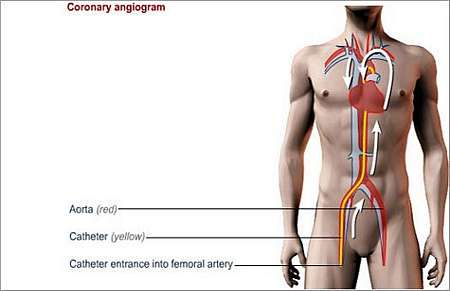What is CARDIAC CATHETERISATION (Cardiac angiogram)?
This test provides extremely important information regarding the blood pressure inside the heart and how efficiently the heart chambers are pumping the blood and how well the heart valves are functioning. It is also very effective in showing narrowing in the coronary arteries.
Cardiac catheterisation can also be carried out on children and even on newborn babies. This will require some sedation and or a general anaesthetic (in which the child is completely asleep).
How is this test performed and how does it assist the clinician with making a diagnosis?
The patient must not eat or drink for 6 to 8 hours before the test. In most cases the patient may leave the hospital on the same day as the procedure has been performed, but in a certain amount of cases a short hospital stay is required. Cardiac catheterisation is performed in an X-ray room and the procedure may take anything from 20 to 60 minutes.

A catheter is a flexible, long, hollow plastic tube, which is about 1 to 1.5 mm in width. This tube is passed into an artery or vein, mostly in the groin area, and less frequently in the arm. The patient has a local anaesthetic to numb the area where the catheter is inserted to make the procedure less painful.
A small incision is made in the skin at the point where the catheter will be passed into the artery or vein. The technician uses an X-ray screen to assist with directing the catheter through the blood vessels and into the correct position in the heart chambers. The patient cannot feel the catheter moving inside their chest, but may become aware of an occasional missed heartbeat or an extra beat from time to time. During the procedure the patient is linked to an ECG monitor, which records the heart rhythm and rate. The patients blood pressure is also monitored at the tip of the catheter.



Fluid is sent down the catheter and a series of pictures (Angiogram X-rays) are taken. In some patients, the fluid may sometimes cause hot flushing sensations that last a few seconds. There may also be a warm sensation experienced in the groin area. Some patients may sometimes feel short or mild chest pain during the procedure. The technician will warn the patient against all these possibilities and it does not necessarily mean that anything is wrong when this happens during the test. The patients doctor will be informed of any and all abnormal sensations and symptoms experienced during the procedure.



After the test has been completed the catheter is removed. A few stitches are usually placed in position where the cut through the skin was made. Positive pressure is applied, for about 10 minutes, to the area where the catheter is removed through the skin. This helps to minimize excessive blood leakage until clotting has occurred. A nurse will examine your groin or arm several times after the test, to check for any possible bleeding. The patient may experience some tenderness at the place where the catheter was inserted for a couple of days after the procedure. The majority of people recover back to normal after about 48 hours.
What risks are involved?
The most common side effect after the procedure is bruising in the groin that usually resolves within a couple of days. The chances of serious complications are about 2 percent. However, in patients where this test is done, the potential risks and complications from disease far outweigh the complications and risks of the procedure itself and the patients doctor will usually clear any doubts in the patients mind before the procedure by having a frank discussion regarding the prognosis of the heart condition under investigation, with and without investigation and treatment.
© 2003 Prometheus™ Healthcare (Pty) Ltd
|